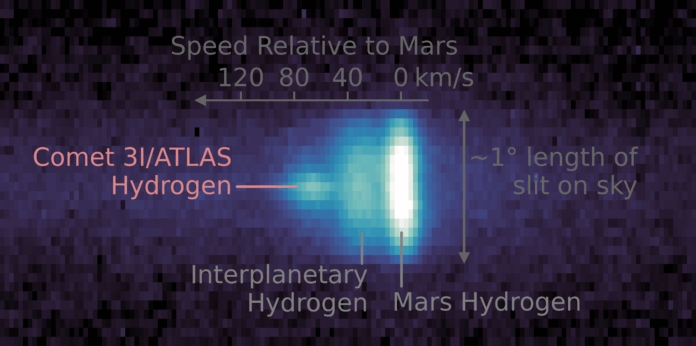
Key Findings
- The ultraviolet data is telling a deeper story than NASA explained.
- The hydrogen envelope around 3I/ATLAS is not behaving like a typical comet cloud.
- The velocity profile shows a structured gradient that raises new questions.
By Samuel Lopez
USA Herald
NASA’s live event today included the release of one of MAVEN’s ultraviolet composite images of 3I/ATLAS captured on September 28, 2025—just days before its close pass by Mars. The agency described it simply: a confined hydrogen signal, distinct from Martian and interplanetary hydrogen, isolated by MAVEN’s spectrographic velocity-sorting mode. But the image itself tells a more complicated story.
Using advanced visual analysis techniques, including pattern-recognition, gradient mapping, and spectral-contrast enhancement, I identified several anomalies in this image that NASA did not mention—each of which deserves scientific attention as public scrutiny grows.
The most striking feature is the internal structure of the comet’s hydrogen emission. NASA characterized the comet’s hydrogen cloud as “small and round,” but the intensity profile shows a clear elongated asymmetry, with the hydrogen region exhibiting a tapered gradient on the left side that is not radially uniform.
Rather than dispersing evenly—as expected from classical water photodissociation surrounding a nucleus—this cloud shows a directional skew aligned with the increasing velocity axis. That skew suggests the hydrogen is not merely drifting outward from a sublimating nucleus; instead, it displays velocity-shear, a feature rarely seen in natural comets and more consistent with directed release patterns.
A second anomaly appears in the transition zone between cometary and interplanetary hydrogen. Instead of a smooth fade, the image reveals a distinct luminosity notch, a dip in hydrogen density that forms a narrow, darker band. This kind of discontinuity could indicate interference between hydrogen sources, but it could also hint at shielding, shadowing, or a structural gap in the emission region around the comet.
Such a gap could be caused by rotation geometry—but it could also indicate that the comet’s hydrogen is not being released evenly around its body, a pattern consistent with asymmetric jets or thermal hotspots.
The third anomaly emerges on the high-intensity right side of the image where the Mars-based hydrogen signal dominates. Directly adjacent to the bright Martian hydrogen spike, the comet’s hydrogen region shows unexpected coherence—it maintains shape and brightness instead of diffusing under stronger nearby emissions. In natural scenarios, cometary hydrogen is easily masked or overwhelmed by nearby high-brightness sources. Here, it retains a confined and stable footprint, suggesting unusually strong cohesion or density within the 3I/ATLAS hydrogen cloud.
Taken together, these anomalies point toward a hydrogen signature that is more structured than NASA’s brief explanation suggests. If sublimation were the only force at work, the hydrogen cloud should be broader, fuzzier, and less coherent. Instead, we are looking at a compact, asymmetrical, velocity-structured hydrogen region that implies controlled emission behavior—either due to unusual chemistry or physical processes not yet accounted for in NASA’s public remarks.
As MAVEN, JPL, and other NASA instruments continue refining their imagery, sharper ultraviolet and infrared views may reveal whether the nucleus geometry, jet configuration, or thermal behavior of 3I/ATLAS matches known comet physics—or whether it continues departing from standard models in ways that mirror Avi Loeb’s concerns about engineered acceleration, jet orientation stability, and uncharacteristic thermal signatures.
For now, the ultraviolet view leaves us with more questions: Why is the hydrogen so compact? Why the directional gradient? Why is the interplanetary hydrogen interface discontinuous? And why didn’t NASA address these features directly?
What remains clear is that 3I/ATLAS continues to challenge expectations, even in wavelengths designed to strip away complexity. The deeper we look, the more structure we find—and with December’s distance window approaching, this may be only the beginning of what these images reveal.


